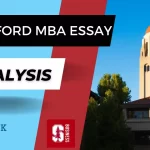MBA Waitlist – How to get off the business school waitlist?
So, you heard back from your target MBA program, but it wasn’t the result you were hoping for; instead, you were placed on the waitlist. So, what should you do now?
The hardest thing for most applicants about being placed on the waitlist is the uncertainty of it all. Being placed on the waitlist for an MBA program does not provide you with a clear next step, unlike being rejected or accepted. It isn’t always obvious what this implies or if there is anything you can do to move up the waitlist and secure a spot for yourself.

But, at Crack The MBA, we view the waitlist as an opportunity – to still be in the game. And, until the game is over, you have a chance. So, that’s a reason to rejoice. To better understand how to manage your participation on the waitlist, let’s first understand what the purpose of a waitlist is.
The waitlist allows business schools to continue to retain applicants in the admissions process as they manage certain other unknown considerations on their end. What does that mean, you ask? So, business schools are looking to shape a class that is diverse and allows them to present their class profile in a way that ideally represents an improvement over the previous year. For instance, if the GMAT was 729 the previous year, improving it to 730 allows them to have a nice buzz going in the media. On the flip side, a 725 would definitely lead to one of those dreaded click-baity headlines in media publications. So, even as schools offer admissions to applicants in a round, they do not know for several weeks and even months whether those applicants would ultimately enroll. In fact, in a pre-COVID conversation with a representative from an M7 school’s admissions team, our team learned that schools can’t be sure about candidates showing up until the new class lands at the school. There can be “no-shows” as late as at that point. With these uncertainties around yield, schools are left with no choice but to go the waitlist route. Apart from the usual waitlist at the time of decisions, there’s also another form of waitlist where schools waitlist candidates even prior to interviewing them. For example, HBS, NYU Stern, and Duke Fuqua. What does that mean? That’s usually an indication of one of two things:
- Schools think your profile is interesting, but want to see more applicants before deciding on whether or not they want to spend their resources on interviewing the candidate
- Schools need you to make more effort with their community and show your interest. For high-touch schools like Stern and Duke, this can especially be important. Why is this important? Candidates who are engaging authentically and meaningfully with these schools signal that they are genuinely interested in the school. This indicates that the chances of these candidates yielding are higher. Yield matters because unyielding candidates send the admissions committee’s plans in a tizzy and result in uncertainty for the school. It’s a precarious balance to be able to shape the class of a top-tier business school and these are the dynamics at play as schools manage their waitlists. So, more often than not, many factors are outside your control.
Why are you on an MBA waitlist?
Speaking of the usual waitlist circumstances, the first thing to know when you end up on an MBA waitlist is that it is a positive sign. It means that your application was convincing, but there could be a few reasons why the admissions committee did not make an offer yet.
There can be quite a few reasons why you ended up on the MBA waitlist. Some of these are listed below:
- Your GMAT/GRE score may be less competitive for your applicant pool. Note that we talk about your applicant pool, and not the class average/mean. This distinction is important as mean GMAT scores for Indian applicants are generally higher than what the class profile shows
- Schools may think your profile could be interesting enough to admit if they have some non-yielding applicants. At the same time, they may not have enough spots to offer you a place just yet
- Not yet compelled by the level of interest you have shown in their program
- Your professional accomplishments may place you a shade below your peers
- Your involvement in your communities may be inadequate
- Competitiveness among your applicant pool
What to do if you end up on an MBA waitlist
If you end up on a waitlist, do not panic and take a deep breath. Do the following things next:
Step 1 – Follow the instructions for the MBA waitlist
Each business school is unique. Some of them will ask you for updates on your profile, while others will make it quite clear that they do not want to have any kind of communication with you at all. Do as instructed. In the event that a school requests no further communication, please respect their wishes.
Fortunately, you may expect business schools to be transparent about their expectations. Pay close attention to and strictly adhere to all of their instructions in any correspondence.
If the school doesn’t want any more contact from you, you’ll just have to wait to hear from them. If, on the other hand, they’re ready to communicate, there are a few good things to do next that we will discuss in the next section.
Step 2 – Decide if you want to wait or not
When you have finished examining your application, you will be in a better position to decide whether or not you want to wait for a response. If you see yourself enrolling in this particular business school in the future, then it makes perfect sense for you to consent to being placed on the waitlist.
You should also factor in the yield rate of the business school that has waitlisted you while making your decision. Lower the yield, greater the movement on the school’s waitlist. The yield rate is the ratio of the number of students enrolled in the MBA program compared to the total number of admission offers made by the school. The pre-COVID yield rates of business schools like Harvard Business School and Stanford GSB have been in the range of 85-90% and Kellogg’s yield has hovered around the 45-50% range. So, it’s probably easier to get off the waitlist at Kellogg as compared to Stanford GSB.
Step 3 – Confirm your candidacy
If you are an applicant who has been waitlisted, you do not want to give the school any reason to question your level of interest in their particular program. This is especially important if the business school in question is one of your top choices. Some schools prefer that you respond through your candidate portal, while others are OK with an email. In either case, be sure to swiftly express your gratitude for the opportunity to be considered further by writing back to the school and reiterating your interest in and enthusiasm for the school.
It’s a good idea to do this if you have confidence that your profile, in particular your GMAT / GRE score, is stronger than average for their class. The fact that they are doubtful as to whether or not you will accept a position is one of the reasons why you may have been placed on the waitlist in the first place. However, this uncertainty is something that can be swiftly and simply dispelled by you.
In any case, it is time to engage in some rigorous and rational reflection about the steps you may take to strengthen your candidacy.
Do you want to get off the business school waitlist?
At Crack The MBA, we have helped hundreds of students get into top MBA programs around the world. We would be happy to help you too. Get in touch with us to learn more about our MBA application services.
How to get off the business school waitlist
To increase the chances of getting off the business school waitlist, you can take the following actions.
Be proactive
Taking initiative is essential for waitlist strategies to succeed. If your score on the GMAT / GRE was on the lower end, you should think about taking the test again. To prove your intellectual prowess, even if your GPA is below average, you may choose to take a relevant online course from a reputable organization. For example, MBA Math or HBS Online CORe. Adding new extracurricular activities can be difficult given the limited time that you have, but there may be new developments within your existing activities of involvement, which you can certainly share.
Retake the GMAT / GRE
Once you’ve shown the admissions team that you’re serious about getting into their program, it’s time to give your application a close look. This is an excellent time to work on any quantitative skills you may lack, such as your GMAT / GRE score. Candidates not only need to know what the average test score is for their chosen school but also what they themselves could be expected to achieve. For instance, Indian engineers have a reputation for being excellent test takers; their average test scores may be 2-5% higher than that of the typical MBA applicant.
Send an update letter
Your final step is to inform the admissions committee of your efforts. The most effective method, provided the business school has allowed you to contact them, is to email them or upload a letter stating developments since you applied.
An effective update letter will incorporate relevant new information rather than restating previously provided details. In addition to the above, consider mentioning any recent professional or personal developments that may have a bearing on your application, such as a promotion at work, any additional reasons for your fit with the program, or the ways in which you will contribute to the school.
Mention any online events or webinars that you have participated in. In addition to the above, you may also include any communication you’ve had with alumni or current students after submitting your application.
Again, it’s important to emphasize what you learned and how those conversations led you to believe that the business school is the best option for you. It is absolutely necessary for you to make it crystal clear that the business school where you are currently on a waitlist is the business school of your choice and that you will unquestionably enroll there if you are admitted there.
You should wait a couple of weeks after receiving your notification to write this letter, as doing so will allow the admissions officers to better gauge how many spots they still need to fill. If the school holds a waitlist webinar, like Duke does, be sure to attend it. If the school allows you to be in communication with a waitlist manager, like Duke does also, make sure you make use of that opportunity. In fact, this is one of the reasons that Duke is also known as a reapplicant-friendly school.
Additional letters of recommendation
Some schools may let you submit extra recommendation letters. You should get in touch with recommenders who can vouch for you and provide fresh insight into your application. Remember, the admissions committee is not interested in going over the same examples that they have read in your previous letters of reference. MBA program alums who know you well can also provide useful feedback to the admissions committee on whether or not you would succeed in the program.
Letter of support
You can also ask a current or former student for a letter of recommendation to vouch for your candidacy and help you in your bid to get accepted into the program. Just so you know, the letter of support is NOT the same thing as the recommendation letter.
For further credibility, try to get a letter of support from a well-respected alumna/alumnus in your industry whom you may have worked with in the past. Keep in mind that the current student or alumnus/alumna should know you very well, either in a professional or personal capacity, or preferably both. You don’t have to have worked with the person, and the letter of support doesn’t have to talk about your work.
Do you want to get off the business school waitlist?
At Crack The MBA, we have helped hundreds of students get into top MBA programs around the world. We would be happy to help you too. Get in touch with us to learn more about our MBA application services.
Things NOT to do while on an MBA waitlist
Don’t pester the admissions committee
Even though it’s good to be in touch with the admissions committee if they allow you, you should also be considerate in your communication. Be proactive but not overbearing. Always keep in mind that the admissions committee is looking at how well you interact with others and represent the school to potential employers. After all, business schools care about their reputation in the community. Make sure you live up to the reputation.
Don’t speak poorly about the school
You should try to keep a great attitude even if you’re feeling down or worried. It would be in poor taste to complain about the school where you intend to receive your education.
Don’t just wait around
Your waitlist status shouldn’t discourage you from working to strengthen your application. Make the most of this window of opportunity by enrolling in additional courses or gaining volunteer experience to bolster your application. These actions could help sway the admissions committee and admit you to the program, especially when choosing between two similar candidates. Furthermore, interest in the school will help convey your continued interest in their program.
Don’t approach the admissions committee without a plan
If you try to get in touch with the MBA admissions committee without a strategy, you run the risk of coming across as confused or less confident. The adcom wants to see that you are genuinely interested in their MBA program, so they’ll look more at your actions than your words or intentions. Therefore, give all of your attention to strengthening your candidacy first and then approach them on how you plan to do it.
Don’t lose hope
If you have been placed on the MBA program’s waitlist, it just means that you are still in consideration for admission. Keep working on improving your application by following the advice we mentioned above. If you follow these steps, you will increase your chances of being taken off the MBA waitlist and accepted into your preferred program.
Final Thoughts
We’d like to reassure everyone who is worried about getting waitlisted by their preferred business schools by saying that every year MBA applicants get off the waitlist and join their dream MBA programs by working judiciously toward their application.
Your clarity of purpose and how you portray it to the admissions committee counts. Do not undersell yourself. Help them see that you are an outstanding applicant and a great match for the business school. Together, we can get you off the MBA program’s waiting list. Please get in touch with us if you have any questions about the waiting list or the MBA application process.






